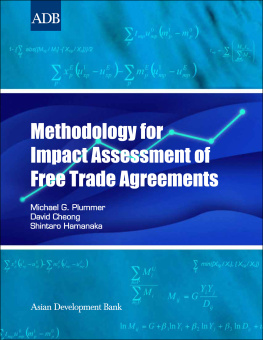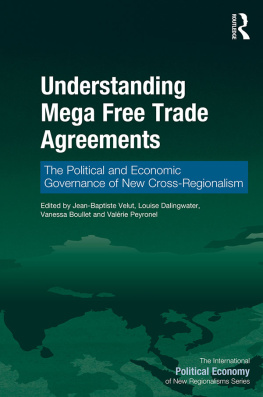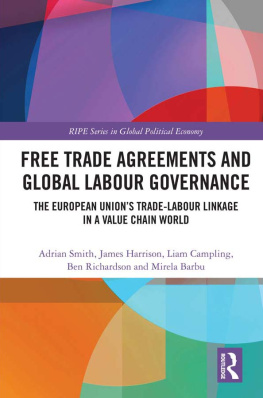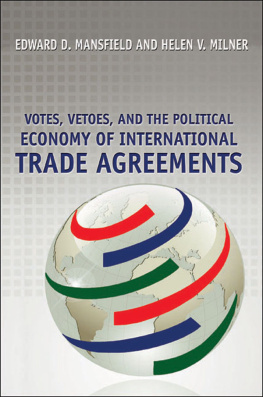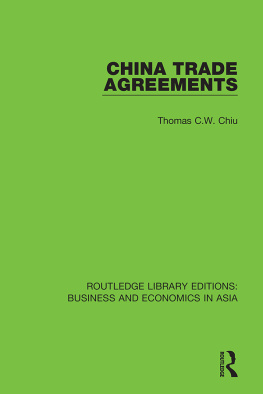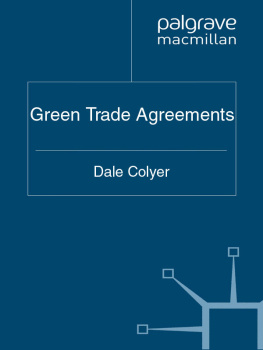List of Tables, Figures, and Boxes |
Preface |
Abbreviations |
Introduction The Menu for Choice |
Variety of Methods |
Impacts of What and Impacts on What |
Structure of the Book |
References (Introduction) |
Chapter 1 Theoretical Framework for Economic Analysis of Free Trade Agreements |
1.1. Viners Model and Extensions |
1.1.1. Viners Model |
1.1.2. Extensions to Viners Model |
1.2. General Equilibrium Models |
1.2.1. MeadeLipsey and WonnacottWonnacott Models |
1.2.2. LloydMaclaren Model |
1.2.3. KempWan Theorem |
1.3. Dynamic Effects of Free Trade Agreements |
1.3.1. Economies of Scale and Variety |
1.3.2. Impacts on Foreign Direct Investment |
1.3.3. Structural Policy Change and Reform |
1.3.4. Competitiveness and Long-Run Growth Effects |
1.4. Theoretical Foundations for Computable General Equilibrium and Gravity Model |
1.4.1. Foundations for Computable General Equilibrium Analysis |
1.4.1.1. Characteristics of Agents in a Typical Computable General Equilibrium Model |
1.4.1.2. Computable General Equilibrium Models of International Trade and Free Trade Agreements |
1.4.1.3. Limitations of Computable General Equilibrium Analysis of Free Trade Agreements |
1.4.2. Foundations for the Gravity Model |
1.4.2.1. Gravity Models and Free Trade Agreement Assessment |
1.4.2.2. Limitations of Gravity Models |
1.5. Concluding Remarks |
References (Chapter 1) |
Chapter 2 Methods for Ex-Ante Economic Evaluation of Free Trade Agreements |
2.1. Trade Indicators to Evaluate the Potential Economic Effects of a Free Trade Agreement |
2.1.1. Indicators of Regional Trade Interdependence |
2.1.1.1. Intraregional Trade Share |
2.1.1.2. Intraregional Trade Intensity |
2.1.1.3. Regional Trade Introversion Index |
2.1.2. Indicators of Comparative Advantage, Regional Orientation, Trade Complementarity, and Export Similarity |
2.1.2.1. Revealed Comparative Advantage |
2.1.2.2. Regional Orientation |
2.1.2.3. Complementarity |
2.1.2.4. Export Similarity |
2.1.3. Strengths and Limitations of Trade Indicators |
2.2. Estimating the Potential Economic Effects of a Free Trade Agreement in an Individual Market |
2.2.1. The SMART Model |
2.2.2. Example of Motorcycle Market in the Lao Peoples Democratic Republic |
2.2.3. Strengths and Limitations of the SMART Model |
2.3. Computable General Equilibrium Estimation of the Potential Economic Effects of a Free Trade Agreement |
2.3.1. The GTAP Model |
2.3.2. Example of Computable General Equilibrium Analysis of a Free Trade Agreement: GTAP Simulation of the Effects of the ASEAN Free Trade Area on Cambodia, the Lao Peoples Democratic Republic, and Viet Nam |
2.3.2.1. Simulated Aggregate Effects |
2.3.2.2. Simulated Sectoral Effects |
2.3.2.3. Simulated Welfare Effects of the ASEAN Free Trade Area |
2.3.3. Strengths and Limitations of the GTAP Model |
2.4. Concluding Remarks |
References (Chapter 2) |
Appendix 2.1: Sources of InputOutput Tables in GTAP 7 Data Base |
Appendix 2.2: Composite Regions and Correspondence with Primary Regions in GTAP 7 Data Base |
Chapter 3 Methods for Ex-Post Economic Evaluation of Free Trade Agreements |
3.1. Free Trade Agreement Preference Indicators |
3.1.1. Coverage Rate |
3.1.2. Utility Rate |
3.1.3. Utilization Rate |
3.1.4. Value of Free Trade Agreement Preferences |
3.1.5. Data Sources: Customs Data and Firm Surveys |
3.1.6. Strengths and Limitations of Free Trade Agreement Preference Indicators |
3.2. Free Trade Agreement Trade and Welfare Indicators |
3.2.1. Qualitative Analysis of Trade Creation and Trade Diversion |
3.2.2. Quantitative Indicators of Trade and Welfare Effects |
3.2.2.1. Trade Volumes and Terms of Trade: Observed Values |
3.2.2.2. Trade Volumes and Terms of Trade: Extrapolated Values with Pre-Free Trade Agreement Growth Rates |

